 |
||
|
||
| ||
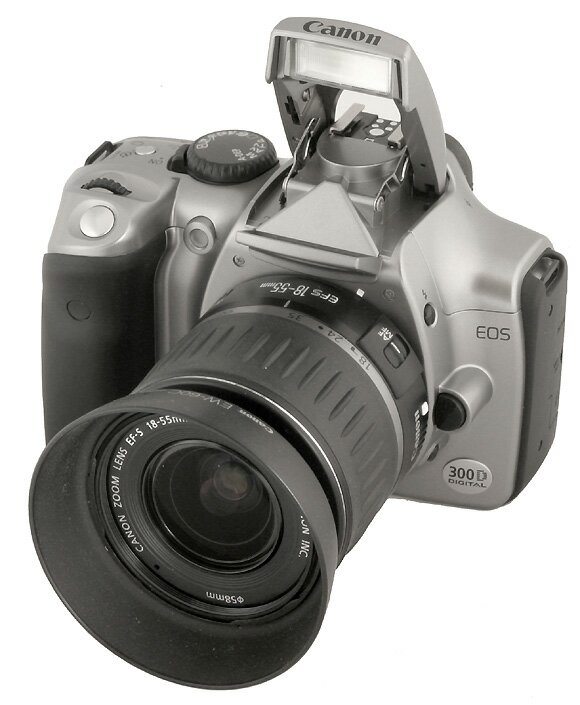 Also known as EOS Digital Rebel in USA and as EOS Kiss Digitalin JapanI happened to get the European version of the EOS 300D camera. In the EOS line the fewer the zeros, the higher the model's level. The company positions this camera as a lower variant of the 10D and considers that professionals should go with the 1Ds. But such separation is conditional, especially it concerns D60, its successor 10D and 300D. These cameras have close technical characteristics similar versions of the 6 Mp CMOS matrix. The functional differences are not considerable either, and only professionals can really distinguish them. Professionals earn money with cameras. And it's quite possible that it is the 300th model that can be an optimal choice as it doesn't make you pay for functions unneeded. Universal solutions are more typical of home PCs than office equipment. The price of about $1,000 makes this camera comparable to its film counterparts. Its price is actually equal to a technically identical film camera with three hundred films in addition. Canon redesigned much the 10D camera to cut its price. Look at the film camera EOS 50 and digital models D60 and 3000D, and you will see that they look very similar. But if the D60 has the same controls as the film one (two dials under the thumb and forefinger, LCD and several buttons controlling the digital part), the new camera has buttons instead of the back dial. 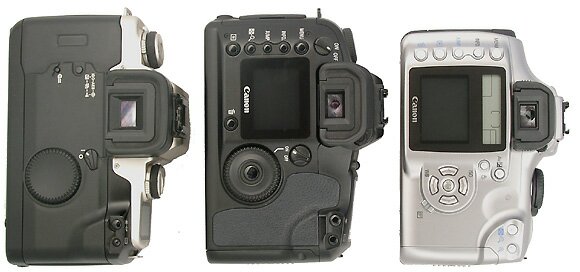 Left to right: EOS 50, EOS D60, EOS 300D The menu navigation and playback are much more handy now. Shots can
be gradually enlarged and shifted up/down of left/right. The other models
have fixed enlargement and sequential switching of fragments with the dial.
But such solution has a downside: exposure correction requires two fingers to press the button (thumb) and rotate the dial (forefinger). Some changes in the management approach were initiated yet in the D30. Although the film camera has an LCD, its switches are much more informative. You can tell what most settings are judging by their positions. In digital cameras you control the camera primarily through the menu. That is why most parameters can be read only on the LCD. 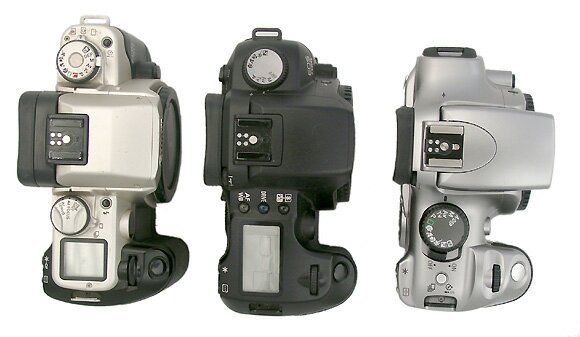 Left to right: EOS 50, EOS D60, EOS 300D  By the way, the new model has the LCD on back instead of on top, and here is how it looks now. The menu is much more branched than in the D60 and 10D. Sensitivity
changes with a dedicated button, ot in the menu. But I don't think that
such ascetic menu affects the camera's performance.
Although the body of the new camera is typical of the EOS line, it has some critical differences. First of all, it has a penta mirror instead of a glass pentaprism. I.e. the image in the viewfinder is inverted not by multiple reflections from the glass/air surface, but by reflections from mirrors the surfaces of which form a pentaprism. It let the developers to reduce the cost and weight. I can't say that such solutions are used mostly in non-professional cameras. The professional roll-film camera Mamiya C33 has a similar penta prism. Although such design is not so durable, I noticed no changes with the pentaprisms of my Mamiya after 30 years os usage. It can't work for centuries, but no one expects such a long life yet. The second change is the support of EF-S lenses, i.e. it can use all old EF lenses plus new ones the flange focal length of which remains the same but the lens juts out of the bayonet. If you attach this lens to the old cameras, the mirror would touch it since its distance from the back lens to the focal plane is shorter. A bit of terminology. The distance between the reference surface of the lens mount and the focal plane is called a flange focal length. The Canon EOS has it equal to 44 mm. When the lens is focused at infinity, the distance along the optic axis from the high point of the back lens to the film plane is called back focus. In wide-angle lenses of reflex cameras the back focus is longer than the focal length. The mirror in the new camera is smaller as the matrix is 1.5 times smaller than the film. According to the developers, the mirror's motion path is different as well. Well, the lighter mirror shakes the camera less, and the smaller back focus allows making cheaper quality wide-angle lenses.  Mirror view. Left to right: EOS 300D, EOS D60, EOS 50 The only aim the developers targeted with the lens (18-55 mm) was to cut the cost price. Its characteristics are almost identical to the film lens for 28-80. But they managed to shorten the focus, and taking into account the smaller matrix size these lenses are equal in the sight angle. That is why you can use the EW-60C blend of the 28-80 film lens with this lens. Fortunately, the lenses have identical blend bayonets. 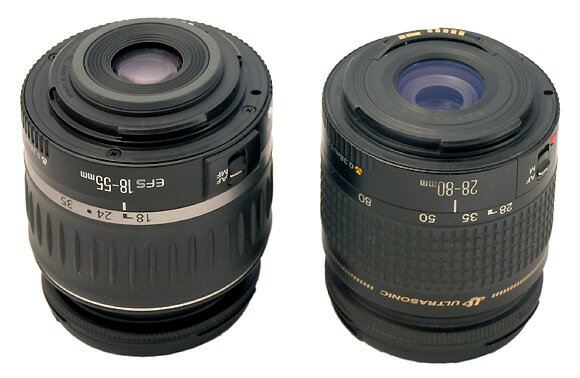 "Canon EF-S 18-55 1:3.5-5.6" vs "Canon EF28-80 1:3.5-5.6 USM III" 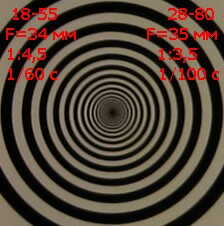 F=34mm 1:4.5 1/60s F=35mm 1:3.5 1/100s The shot is twice enlarged.  The diagrams were drawn with the Levels program by Dmitry Kuznetsov 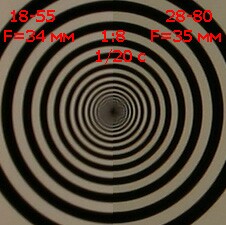 F=34mm F=35mm 1/20s Twice enlarged.  "Canon EF-S 18-55 1:3.5-5.6" vs "Canon EF50 1:1.4 USM" 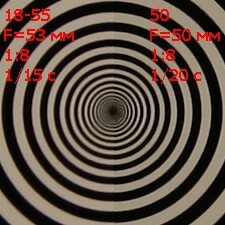 Twice enlarged 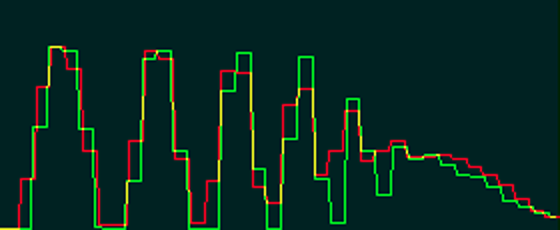 In comparison with one of the greatest lenses Canon EF50 1:1.4 USM the difference can be noticed only on the diagrams. Green stands for Canon EF50 1:1.4 USM, red for Canon EF-S 18-55 1:3.5-5.6. The redesigned lens mount has one more advantage. The mirror doesn't touch anymore the back side of lenses of the Peleng type in case of a poor-quality EOS bayonet-to-M42 adapter, and now it's possible to make an adapter for lenses for old Zenits with the M39 thread. The accessories have become more democratic. The remote control can
be connected to a port like that used in small stereo headphones. Like
in the EOS 50, the camera can be controlled in the IR channel as well.
You can use both RC5 and the old remote control of the EOS 50 - RC1. The
PC connection cable is of the miniUSB standard. However, it doesn't support
a non-automatic flash via a separate synchronizer.
The built-in flash is also redesigned. Now it goes up higher. On one hand, it reduces the redeye effect, on the other hand, blends and long-focus lenses do not cover the object from the built-in flash light. 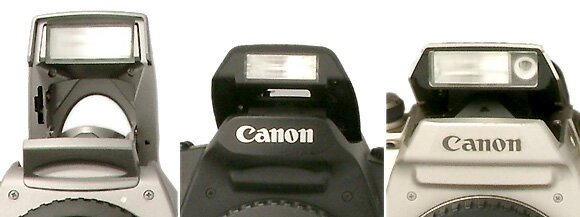 Left to right: EOS 300D, EOS D60, EOS 50 The flash management features are limited: the second-curtain synchronization is not supported, and you can't change exposure when shooting in the aperture priority mode. I think that photo amateurs wouldn't care, and professionals would use an external flash anyway. The tests with the Sigma EF-500 SUPER flash showed that the second-curtain synchronization can be enabled in the Flash menu. The flash floodlight is used to highlight autofocusing in the dark. When you press the aperture repeater button the aperture shrinks to the ready-to-work position and the flash emits a series of pulses in the stroboscopic mode so that you can estimate shadows. The electronic part is also redesigned. All electronic components are mounted on fewer boards, the buffer is smaller and now it houses only 4 frames in series shooting the rate of which is 2.5 shots per second. It's equal to the D60 but less than in the 10D. The matrix is identical to the 10D. It seems that the company follows a very thrifty approach using the matrices which do not satisfy the 10D. However, they say that the matrices in the new cameras have a different package. That is why the culling, if it takes place at all, is performed at a much earlier stage, before the die is packed, which is hardly possible. 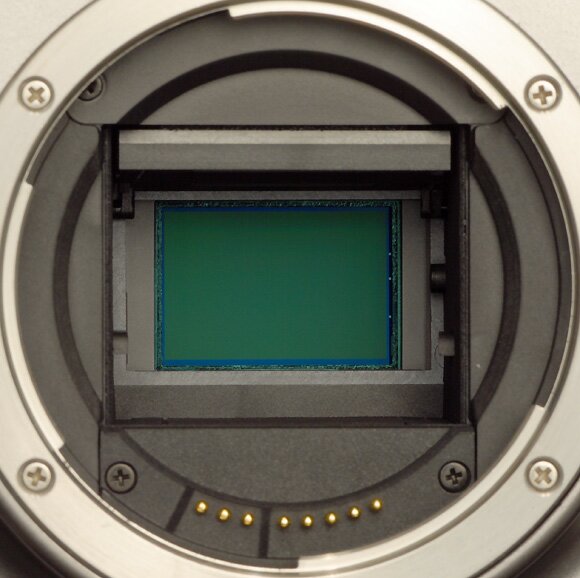 First I thought that the matrix is noisier, but it turned out to be
wrong. The camera has two sets of parameters. In the first mode (Parameter
1) the sharpness, contrast and saturation are increased by 1, which at
high sensitivity level accentuates noise; in the second mode (Parameter
2) when the correction is equal to 0, there's almost no difference from
the D60.
 Here are two tables demonstrating the Parameter 1 and Parameter 2 modes. Shots taken with the halogen lamp. The white balance set to the incandescent lamp mode. In such illumination the noise level must be maximum in the blue channel. 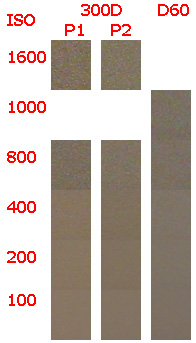 The rectangles of 40x50 pixels are cut out from the above grey tables. Shots recorded in CRW . Parameters set before shooting. Two shots were taken at both sensitivity levels, though in CRW the parameters can be changed right in the shots. The rectangles are brought together and recorded into one JPEG file. The size is enlarged twice. Below you can see average brightness and standard deviation.
The new parameters which determine shot pre-processing let the camera work without PC and send shots directly to the printer. Digital Print Order Format (DPOF) and Exit Print standards supported. PhotoThe following photos demonstrate rather the possibilities of the removable optical system than the camera itself. All shots are taken from the same point. Click on the photo to see the original. 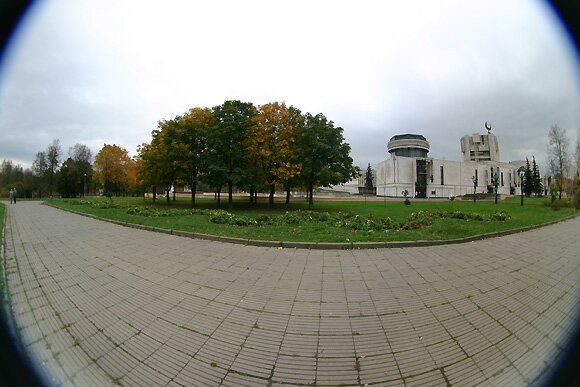 "MS Peleng 3.5/8". F=8 mm 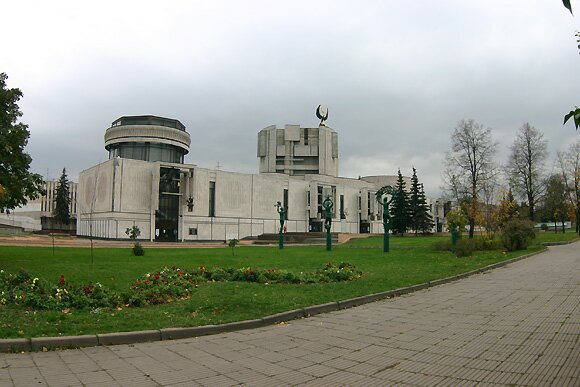 "MS Zenitar-M 2.8/16". F=16mm. 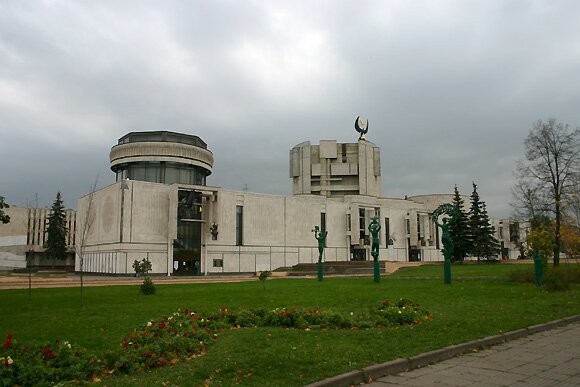 "Canon EF-S 18-55 1:3.5-5.6". F=18mm. 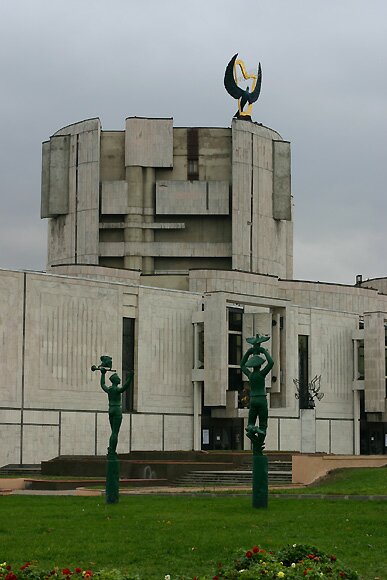 "Canon EF50 1:1.4 USM". F=50mm. 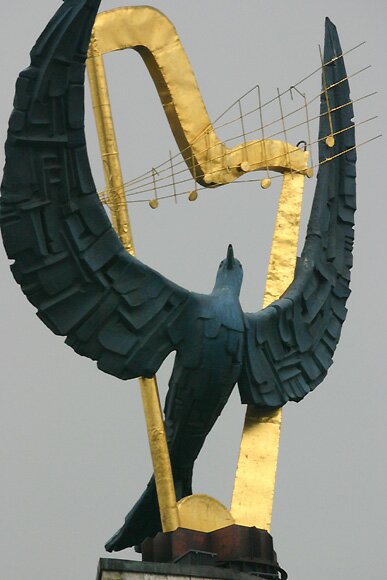 Catadioptic lens "MS RUBINAR-8/500 MACRO". F=500mm. Here are some macro shots taken manually with the Rubinar lens at ISO 800. At such sensitivity the noise level is pretty high, but the Neat Image program allows smoothing it away without noticeable loss of detail. 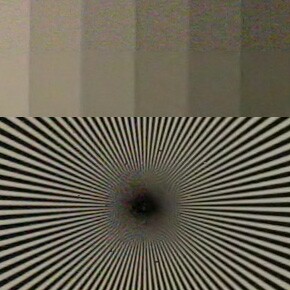 You can see the fragments of the same shot taken at ISO 1600 before and after noise elimination. The shot is twice enlarged. Below is the grey scale after the Neat processing. On the right is the resolution chart after the Neat processing.   ConclusionSo, this reflex camera can be of much interest for those who have removable
optical systems and want to use it with digital cameras as well. This model
can be an optimal solutin for those professionals who need a reflex camera
for micro and astro shooting. Most scientific devices were designed to
match the M42 thread. This camera can successfully replace a film one in
such devices. It makes no sense to buy a more expensive model as in this
case the requirements for the body life are minimal and the potentially
shorter life compared to the 10D is long enough to wait till the next generations
of cameras the price of which will be lower than the price gap between
the 300D and 10D.
Write a comment below. No registration needed!
|
Platform · Video · Multimedia · Mobile · Other || About us & Privacy policy · Twitter · Facebook Copyright © Byrds Research & Publishing, Ltd., 1997–2011. All rights reserved. | ||||||||||||||||||||||||||||||||||||||||||||||||||||||||||||||||||||||||||||||||||||||||||||||||||||||||||||||||||||||||||||||||||||||||||||||||||||||||||||||||||||||||||||||||||||||||||||||||||||||||||||||||||||||||||